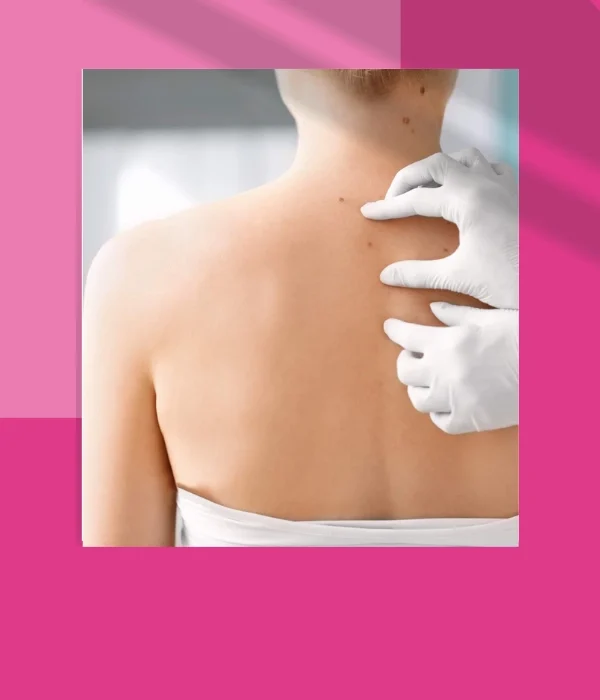Skin Tags, Moles & Warts Removal Treatment
If you’ve ever had a skin tag, mole or wart, you’ll know how unsightly and bothersome they can be. But what are they, exactly, and how can you get rid of them?

Skin tags, moles, and warts are all common skin growths that can appear on various parts of the body. Skin tags are small, fleshy growths that typically appear in areas where the skin rubs against itself, such as the neck, armpits, and groin. Moles, on the other hand, are usually dark brown or black and can appear anywhere on the body. Warts are small, rough bumps that can appear on the hands, feet, and other areas.
While skin tags, moles, and warts are generally harmless, they can be unsightly and cause discomfort, especially if they’re in a prominent location or get irritated or inflamed. Fortunately, there are several effective methods for removing them.
The exact causes of skin tags, moles, and warts are not well understood, but there are several factors that can increase your risk of developing them. These include:
- Age: Skin tags, moles, and warts are more common in older adults.
- Genetics: Certain genetic factors can make you more susceptible to developing skin growths.
- Hormonal changes: Changes in hormone levels during pregnancy or puberty can cause skin tags or moles to develop.
- Friction: Skin tags are often caused by skin rubbing against skin or clothing.
- Sun exposure: Warts can be caused by exposure to the human papillomavirus (HPV), which can be spread through skin-to-skin contact or contaminated surfaces.
- Weakened immune system: A weakened immune system can make you more susceptible to developing warts.
There are several different types of skin tags, moles, and warts, each with their own distinct characteristics. Some common types include:
- Acrochordons: These are the most common type of skin tag, and are typically found in areas where the skin folds or creases.
- Seborrheic keratoses: These are benign skin growths that can appear as light or dark brown spots.
- Congenital moles: These are moles that are present at birth and may be larger than other moles.
- Junctional moles: These moles are typically brown or black and can appear anywhere on the body.
- Common warts: These are raised, rough growths that can appear on the hands, feet, and other areas.
- Plantar warts: These are warts that develop on the soles of the feet and can be painful to walk on.
The signs and symptoms of skin tags, moles, and warts can vary depending on the type and location of the growth. Some common signs to look out for include:
- Skin tags: Small, fleshy growths that are typically skin-colored or slightly darker. They may be smooth or wrinkled and can range in size from a few millimeters to several centimeters.
- Moles: Dark brown or black growths that are usually round or oval in shape. They may be flat or raised and can range in size from a few millimeters to several centimeters.
- Warts: Small, raised bumps that may be rough or smooth. They can be skin-colored or slightly darker and can range in size from a few millimeters to several centimeters. Plantar warts may have small black dots in the center and can be painful to walk on.
There are several professional removal procedures available. Some common methods include:
- Cryotherapy: This involves freezing the growth with liquid nitrogen, causing it to eventually fall off.
- Excision: This involves cutting the growth off with a scalpel or scissors.
- Electrocautery: This involves burning the growth off with an electrical current.
- Laser therapy: This involves using a laser to destroy the growth.
Your doctor can help you determine which removal method is best for your individual situation.
After having a skin tag, mole, or wart removed, it’s important to properly care for the area to ensure proper healing and minimize the risk of infection. Some tips for aftercare and recovery include:
- Keep the area clean and dry: Clean the area gently with mild soap and water and pat it dry with a clean towel.
- Avoid touching or picking at the area: This can increase the risk of infection and slow down the healing process.
- Apply an antibiotic ointment: Your doctor may recommend applying an antibiotic ointment to the area to help prevent infection.
- Cover the area with a bandage: If the area is in a location where it may be rubbed or irritated, your doctor may recommend covering it with a bandage.
- Avoid strenuous activity: Avoid activities that may cause excessive sweating or friction in the area, such as exercising or wearing tight clothing, until the area has fully healed.
- Follow your doctor’s instructions: Your doctor will provide you with specific aftercare instructions based on the removal method used and your individual situation. Be sure to follow these instructions carefully to ensure proper healing.
While it’s not always possible to prevent skin tags, moles, and warts, there are several steps you can take to reduce your risk of developing them. These include:
- Practice good hygiene: Wash your hands regularly and avoid touching your face and other parts of your body with unwashed hands.
- Wear shoes in public areas: To reduce your risk of contracting HPV, wear shoes in public areas such as locker rooms, showers, and swimming pools.
- Avoid sharing personal items: Do not share personal items such as towels, razors, or nail clippers with others.
- Protect your skin from the sun: Use sunscreen and wear protective clothing to reduce your risk of developing moles and other skin growths.
While most skin tags, moles, and warts are harmless, there are certain situations where you should seek medical attention. Some signs that you should see a doctor include:
- Rapid growth of a skin growth
- Changes in the color, shape, or size of a skin growth
- Bleeding or oozing from a skin growth
- Pain or discomfort associated with a skin growth
In addition, if you’re unsure whether a skin growth is a skin tag, mole, or wart, or if you’re concerned about the safety or efficacy of a home remedy or over-the-counter treatment, it’s best to seek medical advice.
Are skin tags, moles, and warts contagious?
Skin tags, moles, and warts are generally not contagious. They are caused by a variety of factors, including genetics, age, and exposure to certain viruses, and are not typically spread through direct contact.
How long does it take to remove a skin tag, mole, or wart?
The time it takes to remove a skin tag, mole, or wart will depend on the removal method used and the individual situation. Some methods, such as cryotherapy, may only take a few minutes, while others, such as surgical excision, may require several weeks of healing time.
Is it safe to remove a skin growth at home?
While there are several home remedies available for removing skin tags, moles, and warts, it’s important to proceed with caution. Some home remedies may be ineffective or even dangerous, and could lead to infection or scarring. It’s always best to consult with a doctor before attempting to remove a skin growth at home.
Will removing a skin tag, mole, or wart leave a scar?
The risk of scarring after skin tag, mole, or wart removal will depend on several factors, including the removal method used and the individual’s skin type. In some cases, there may be minimal scarring, while in others, there may be more noticeable scarring. Your doctor can provide guidance on minimizing the risk of scarring.
Can skin growths come back after they’ve been removed?
In some cases, skin growths may grow back after they’ve been removed. This is more likely to occur with certain removal methods, such as shaving or snipping, as opposed to surgical excision. It’s important to follow your doctor’s aftercare instructions carefully to minimize the risk of recurrence.
When choosing a skin clinic for skin tags, moles, and warts removal treatment, it’s important to consider the following factors:
Experience and expertise: Veeha Skin Clinic has experienced and knowledgeable dermatologists, who specialize in skin tags, moles, and warts removal treatment.
Treatment options: We offers a variety of treatment options, so that you can find the best treatment for your individual needs.
Personalized treatment plans: We work with you to develop a personalized treatment plan that addresses your individual needs and concerns.
Quality of care: We have prioritizes patient safety, with evidence-based treatments.
Reputation and reviews: We have good reputation and positive reviews from previous patients.
Location and Accessibility: We have well-located and accessible clinic so you can easily attend appointments and receive ongoing treatment as needed.
By considering these factors, you can choose Veeha Skin Clinic for skin tags, moles, and warts removal treatment.
Book Now
Make An Appointment
Consult with Rajkot leading Dermatologist & Cosmetologist, Dr. Pratik Siddhapura M.D Skin. He has many years of experience in skin tags, moles, and warts removal treatment, he will evaluate your individual skin condition and discuss the treatment options with you. You may also send an Online consultation request by contacting us : https://veehaskinclinic.com/contact-us/. Our team will respond to your questions or appointment request as soon as possible.
Opening Hours
- 09.30 AM - 02.30 PM
- 04.30 PM - 08.30 PM
- Closed
Support
You can contact us through phone, whatsapp & email. Online video consultations are also available.

